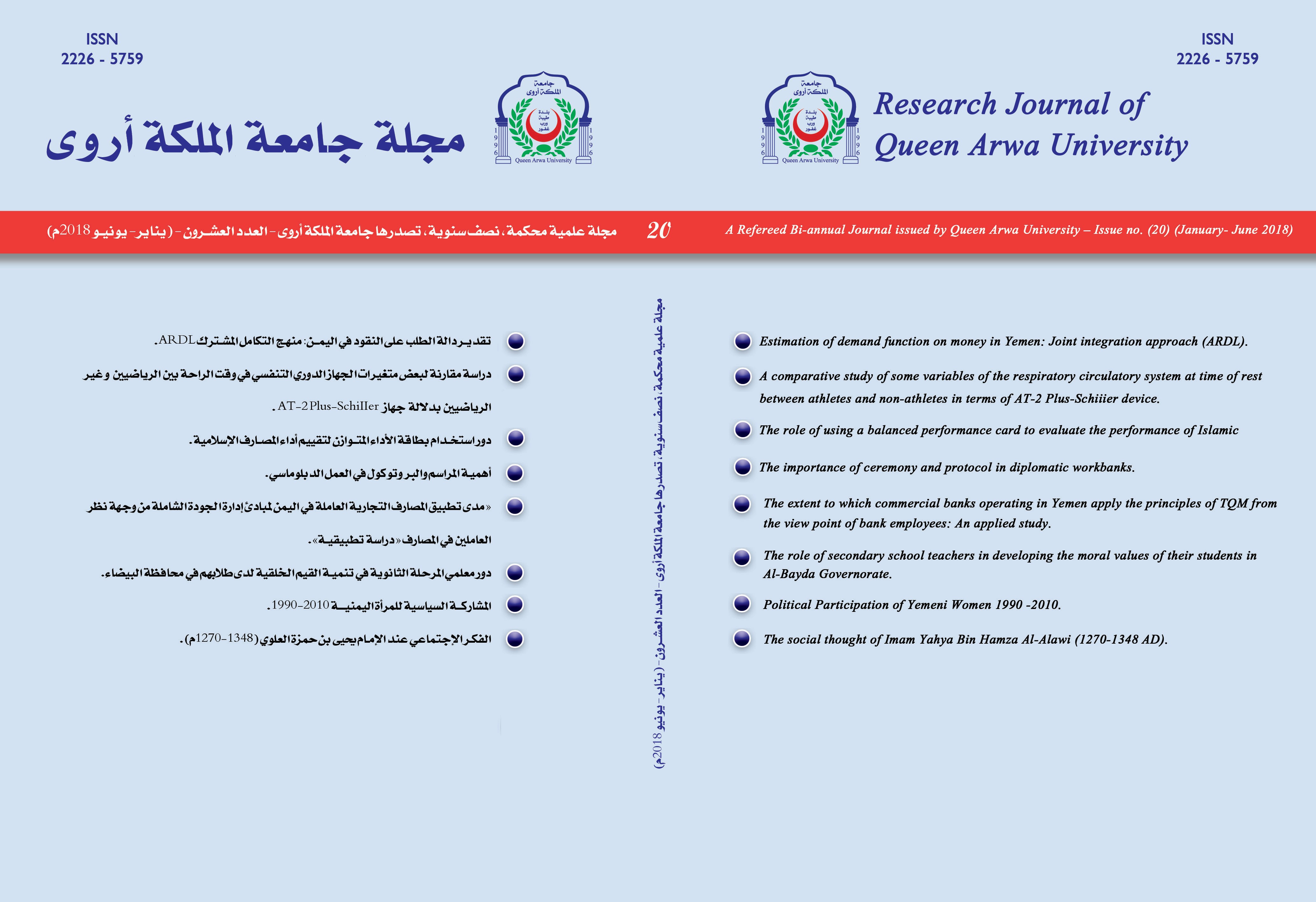Estimating the demand function for money in Yemen
ARDL cointegration approach
DOI:
https://doi.org/10.58963/qausrj.v1i20.178Keywords:
Cash balances , Yemeni economy , interest rateAbstract
In this paper we investigate both the long and short-run relationship between real money balances, real income, inflation rate, foreign interest rate and real effective exchange rate with reference to Yemen over the period 2005:01-2014:11 using ARDL approach which is a newly developed econometric technique. The estimated results indicate that in the long-run real income, inflation rate, interest rate and nominal exchange rate have a significant impact on real money balances in Yemen. The dynamics of real money demand show that the effects interest rate and the exchange rate are much smaller in the short run than long run. The results also reveal that the demand for real money balances in Yemen is stable. The a stable demand for money function is essential for the conduct of effective monetary policy.
Downloads
References
المراجع باللغة العربية
الحكيمي، سيف سلام (2008): "قياس استقرار دالة الطلب على النقود"، مجلة شؤون العصر، السنة الثانية عشرة، العدد: الثامن والعشرون.
المراجع باللغة الانجليزية
Abdulkheir, A.Y., (2013), “An Analytical Study of the Demand for Money in Saudi Arabia”, International Journal of Economics and Finance, Volume: 5/4, pp. 31-38, Canada.
Agenor, Pierre-Richard and Mohsin Khan.(1996), "Foreign Currency Deposits and Thedemand for Money in Developing Countries". Journal of Development Economics: pp. 101-118.
Anwar, S. and Asghar, N. (2012), “Is Demand for Money Stable in Pakistan”, Pakistan Economic and Social Review, Volume: 50/1 (Summer 2012), pp. 1-22, Pakistan.
Arango, S. and Nadiri, I.M. (1981), “Demand for Money in Open Economies”, Journal of Monetary Economics, Vol.7, No.1, pp. 69-83.
Baharumshah, Ahmad Zubaidi, Siti Hamizah Mohd and A. Mansur M. Masih (2009), “The stability of money demand in China: Evidence from the ARDL model”, Economic Systems, 33(3): 231-244.
Brown, R. L., J. Durbin, and J. M. Evans (1975), "Techniques for Testing the Constancy of Regression Relationships over Time". Journal of the Royal Statistical Society. Series B (Methodological) 37: 149-192.
Budha, B. B. (2012), "Demand for Money in Nepal: An ARDL Bounds Testing Approach" NRB Working Paper No. 12. Nepal Rastra Bank, Nepal.
Budha, B.B. (2011), "An Empirical Analysis of Money Demand Function in Nepal." Economic Review, Occasional Paper, No 23. Nepal Rastra Bank, Nepal.
Chaisrisawatsuk, S., S. C. Sharma, and A. R. Chowdhury (2004), "Money Demand Stability under Currency Substitution: Some Recent Evidence". Applied Financial Economics 14: 19-27.
Darrat, A. F., and A. Al-Mutawa (1996), "Modelling Money Demand in the United Arab Emirates". Quarterly Review of Economics and Finance, 36: 65-87.
Dritsakis, N. (2011), “Demand for Money in Hungary: An ARDL Approach”, Review of Economics and Finance, November 2011, pp. 1-16, Canada.
Engle, R. F., and C. W. J. Granger (1987), "Co-Integration and Error Correction: Representation, Estimation, and Testing". Econometrica 55: 251-276.
Goldfeld, S.M. & Sichel, D.E. (1990), "The Demand for Money", in: Friedman and Hahn, eds., Handbook of Monetary Economics. Amsterdam: Elsevier Science Publishers. pp. 300-356.
Imimole, B., Uniamikogbo, S. O.,(2014), "Testing for the Stability of Money Demand Function in Nigeria", Journal of Economics and Sustainable Development, Vol. 5, NO: 6, ISSN 2222-1700 (Paper) ISSN 2222-2855 (Online). www.iiste.org
Johansen, S. (1992) "Testing Weak Exogeneity and the Order of Cointegration in Uk Money Demand Data". Journal of Policy Modelin". 14: 313-334.
Johansen, S., and K. Juselius (1990) "Maximum Likelihood Estimation and Inference on Cointegration—with Applications to the Demand for Money". Oxford Bulletin of Economics and Statistics, 52: 169-210.
Kjosevski, J.(2013) "The determinants and stability of money demand in the Republic of Macedonia", Zb. rad. Ekon. fak. Rij. vol. 31. sv. 1: 35-54
Maravić, Jelana, and Mirjana Palić (2010), “Econometric Analysis of Money Demand in Serbia”, Working Paper.
Narayan, P.K., (2005), "The saving and investment nexus for China: evidence from cointegration tests". Appl. Econ. 37, 1979–1990.
Obben J. (1998), "The demand for money in Brunei", Asian Economic Journal, Vol: 2, No: 12, pp. 109-121.
Oluwole, O. and Olugbenga, A. O. (2007). “M2 targeting, money demand, and real GDP growth in Nigeria: Do rules apply?”, Journal of Business and Public Affairs, 1(2): 1-20.
Pesaran, M. H., and B. Pesaran (1997) Microfit 4.0 (Window Version). New York: Oxford University Press.
Pesaran, M. H., Shin, Y., Smith, R.J. (2001), “Bounds Testing Approaches to the Analysis of Level Relationships". Journal of Applied Econometrics, 16: 289-326.
Pesaran, M. H., Y. Shin, and R. J. Smith (1996) Bounds Testing Approaches to the Analysis of Level Relationships. DEA Working Paper 9622, Department of Applied Economics, University of Cambridge.
Walsh, C. E. (2003), "Monetary Theory and Policy". Second Edition. The MIT Press, USA.
Weliwita, A., and E. M. Ekanayake (1998) Demand for Money in SriLanka during the Post-1977 Period: A Cointegration and Error Correction Analysis. Applied Economics, 30: 1219-1229.
Downloads
Published
Issue
Section
Categories
License
Copyright (c) 2018 by the Author(s) mentioned in this article.

This work is licensed under a Creative Commons Attribution 4.0 International License.













